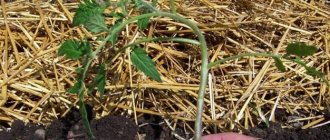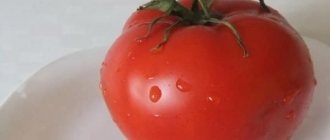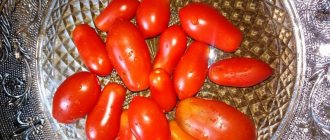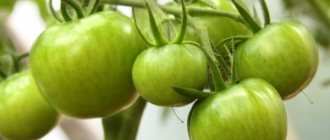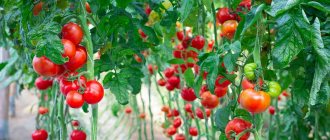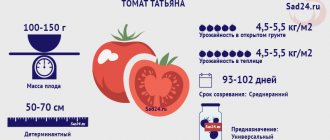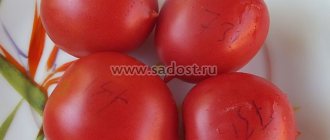Description of the variety
The Mishka clubfoot variety belongs to the indeterminate type of plants, that is, the crop is not limited in growth. The leaves are dark green and medium in size. Tomatoes of this variety are successfully grown both in greenhouse conditions and in open ground. The culture needs garter and stepsoning.
Varieties of tomatoes Teddy bear
The variety has several varieties:
- Yellow. A vegetable with a pleasant, richly sweet taste. The bush reaches a height of 2 m. The culture has strong immunity to fusarium, alternaria and tobacco mosaic virus. Vegetable growers speak positively about tomatoes.
- Red. This variety is the most famous. Tomato stems reach a height of 2 m. The crop is mainly grown in greenhouse conditions. The fruits and pulp have a rich crimson color. The vegetables taste sweet and tender. Summer residents collect 5-6 kg from one bush. The plant has strong immunity to characteristic tomato diseases.
- Orange. Bright tomatoes decorate beds well. The fruits are fleshy, aromatic, sweet and juicy. The use of vegetables is universal - they are used in fresh salads and for preservation. The plant grows strongly and requires pinching. It is formed into two stems. The culture is resistant to most diseases.
- Pink. When the fruits of this variety hang on the bushes, they look like large pink drops. Each reaches 800-900 g. Up to 6 kg of crop is harvested from one plant. The mid-season variety needs pinching.
Reference. Multi-colored vegetables taste virtually the same.
Distinctive features
The variety produces a bountiful harvest in open and closed ground and has strong immunity to most diseases. Elastic fruits tolerate transportation well and are stored for a long time. If the vegetable is picked green, it will ripen perfectly on its own on the windowsill or in the pantry.
Fruit characteristics and yield
The clusters bear 5 fruits. The weight of one tomato is 700-800 g, but with good care it can reach 900 g. Tomatoes have a heart-shaped round shape, thin skin and juicy pulp. There are few seeds in tomatoes. The vegetables taste sweet, without a sour aftertaste. The largest fruits grow on the first clusters, slightly smaller on subsequent clusters. From 4 to 6 kg of crop is harvested from one bush.
Diseases
Tomatoes are very resistant to late blight and tobacco mosaic, but can sometimes suffer from gray or white rot. To prevent the appearance of rot, you need to regularly loosen the soil, mulch the bushes, and remove weeds and lower leaves.
Bushes can be attacked by slugs, from which a solution of ammonia can help. Also, sometimes flying pests settle on plants, against which various insecticides are used, which can be bought at a farm store.
As mentioned earlier, the tomato variety Mishka clubfoot is resistant to most diseases. However, these tomatoes are occasionally affected by rot. True, this happens due to errors in care. Therefore, if you want to avoid the appearance of any rot, then loosen the soil more often, regularly remove weeds and tear off the lower leaves.
How to grow seedlings
The Mishka clubfoot variety is grown in seedlings. The seeds for this are sown in the last ten days of March. The soil can be purchased from a specialized store or prepared independently.
Seed preparation
The seed package will indicate whether the grains have been pre-treated by the manufacturer. In any case, the material is rejected. The grains are placed in a 3% saline solution (30 g of salt is stirred in 1 liter of water) for 20-30 minutes.
Seeds that fall to the bottom of the container are selected for planting, and those that float are thrown away. Then the grains are washed under running water and disinfected in a 1% solution of potassium permanganate.
The washed seeds are germinated. To do this, they are laid out on damp cotton cloth or cotton pads and placed in a container that is sealed using plastic bags. The grains are periodically moistened.
Important! The seed material is only moistened. The grains should not float.
Germination at room temperature +25 °C takes 3-4 days. When the length of the sprout matches the size of the grain, it means the seeds are ready for sowing.
Container and soil
To grow seedlings, use wooden or plastic boxes, cut bottles or milk cartons, cups or peat tablets. The latter option is most preferable, since such containers contain a nutritious soil mixture.
When picking, the peat cup along with the seedlings is moved into a large container. After some time, the walls of the container become limp and dissolve in the soil. At the same time, the root system remains intact, and the plant itself does not experience stress when conditions change.
The following components are mixed for the soil:
- manure – 1 part;
- river sand – 1 part;
- neutral peat – 1 part;
- garden soil - 3 parts.
Important! 1-2 days before sowing, the finished soil is disinfected with a strong solution of potassium permanganate. After the procedure, beneficial bacteria begin to develop in the soil for crop growth.
Sowing
Tomato seeds are planted 1-2 cm into the soil and lightly sprayed so as not to erode the soil. Next, the container with grains is covered with polyethylene and placed in a heated place until germination. When the first shoots appear, the shelter is removed and the seedlings are placed in a bright place, for example, on a windowsill.
Growing and care
To keep young plants strong and healthy, they are watered in a timely manner and provided with sufficient light. The seedlings are kept indoors at a temperature of +25 °C. When the young plants have 2 true leaves, they are planted into separate containers.
For good seedling development, do the following:
- When transplanting, the sprouts are deepened almost to the cotyledon leaves.
- Plant roots are disinfected in a weak solution of potassium permanganate.
- 10-14 days after picking, the tomatoes are fed for the first time. Further fertilizing is applied every 10-14 days. Mullein infusion is used as a fertilizer.
- Tomato seedlings are hardened. Two weeks before the intended planting, the plants are taken out onto the street or balcony for 1-2 hours. The time the seedlings spend in the fresh air is gradually increased.
Agricultural technology
This species is often grown by seedlings. To get a decent tomato harvest, sow selected seeds in mid-March, 60 days before planting the sprouts in the ground.
The soil composition for sowing is prepared from garden soil with the addition of high-quality humus and peat. In order to increase the nutritional value of the variety, homemade tree resin and superphosphate are added to the soil.
The acquired seeds are sown with a slight depth of 2 cm. If desired, before sowing, the seeds are treated with growth stimulants and disinfected with a manganese solution.
Caring for tomato seedlings
In order for the sprouts to be strong and healthy, it is necessary to provide them with high-quality watering and a sufficient amount of light.
A couple of weeks before the immediate planting of young seedlings, they are hardened by the street temperature. For this purpose, the sprouts are taken out into the air, gradually increasing the residence time. Tomato seedlings require three applications of high-quality mineral compounds. It also requires moderate watering, the optimal growing temperature is 20-22 degrees.
Caring for tomato seedlings
Landing in an open area
When the sprouts have at least 6 leaves, they are planted in open ground. Sprouts are placed in open ground at the beginning of the summer season - in June. Flowering of home seedlings does not affect transplantation. When planting, maintain a distance between bushes of 40 cm. The permissible row spacing is 50 cm. A little later, the bush is formed into two stems. For this purpose, all stepsons above the second hand are destroyed. In order for the bush to be powerful and developed, the growth point is pinched, destroying the characteristic deformed inflorescences.
Features of care
Resistant tomato varieties require regular care for comfortable development. By pinching growth points and removing shoots, tall tomato bushes are formed. This variety loves moisture, so it requires regular watering. To reduce the evaporation of life-giving moisture, the tree trunk circle is covered with mulch. Suitable materials for mulch include forest straw, sawdust, grass clippings, and high-quality humus.
It is important to remember that tomatoes react poorly to humidity and, as a result of stagnation, mold can form, which negatively affects the root system.
Features of care
Any variety of tomatoes prefers nutritious soil; throughout the growing season, the bushes are fertilized with high-quality mineral or organic components. Rotted manure can be used as nutritional components. Fresh manure should be discarded, as it negatively affects the yield of the species.
The smooth tomato Mishka clubfoot, the characteristics and description of the variety have been studied, has increased resistance to destructive late blight and dangerous fungal diseases.
Attention! To prevent rotting of the bushes, it is recommended to loosen the root zones more often, destroy weeds, and pick off the lower leaves. If necessary, bushes are treated with insecticides
Stepson and garter
In order for the bushes to develop better and have a decent harvest, they pinch the growth point of the bush and get rid of deformed inflorescences. As the bush develops, it is planted into 2 stems. Improper planting threatens to reduce yields.
Diseases and pests
As is known, domestic breeders have endowed this species with powerful immune protection against popular diseases of Solanaceous crops: destructive late blight, tobacco mosaic. But despite this, crops can be affected by various types of rot. The procedure of loosening and mulching the tree trunk circle, removing excess weeds and lower leaves on succulent trunks can protect the plantings.
Tomatoes are rarely attacked by pests, but preventive measures will help protect young plantings. An aqueous solution of ammonia gets rid of dangerous slugs that spoil sprouts.
Teddy Bear
How to grow tomatoes
Proper cultivation of the Mishka clubfoot variety consists of timely moistening and loosening the soil and periodically weeding the beds to remove weeds. Although the crop has good immunity to diseases, vegetable growers treat the soil with a weak solution of potassium permanganate for prevention.
Landing
When young plants have 6-7 true leaves, they are transplanted to a permanent place of growth. This is usually done at the end of April - beginning of May. Tomatoes are planted under shelter according to a 30x50 cm pattern. As they grow, each plant is carefully tied to a support.
Tomatoes are transplanted into open ground in early June. Since the plants are tall, leave 50 cm between rows and 40 cm between bushes.
Care
Tomatoes are watered regularly and abundantly, preventing the soil from drying out. But excessive moisture also has a bad effect on plants. The procedure is performed in the morning or evening hours, when the sun is not shining. Use settled water at room temperature. Water the bushes at the roots.
To form large and fleshy vegetables, the crop is fertilized once every 14 days throughout the growing season. Organic and mineral fertilizers are alternated as fertilizing. They try not to use manure, as it promotes the growth of green mass and weeds, which slows down the development of fruits.
The variety is formed into 1-2 stems. All stepsons that are located above the second hand are removed. Shoots longer than 5 cm are cut off. For better development of the stem, pinch the top of the plant and remove deformed flowers.
When white tubercles appear on the stem at the base, the bushes spud. This means that due to a lack of nutrients, the plant intends to strengthen the root system.
The variety is indeterminate; its shoots are long and weak. Therefore, the crop cannot withstand the load of heavy fruits without support. A tall variety is tied to a trellis or stake.
Did you know? Tomatoes contain a large amount of serotonin (the hormone of happiness), so this wonderful vegetable can lift your spirits just as well as chocolate. The bright color of the fruit also helps with this.
Possible difficulties during cultivation
To obtain a bountiful harvest, the crop is provided with timely watering and regular fertilizers.
Diseases and pests
The tomato variety Mishka clubfoot shows good resistance to the following diseases:
- late blight;
- fusarium;
- tobacco mosaic.
There is a small risk of the crop being affected by white or gray rot. Apical or root rot also occurs. Often, ripe vegetables begin to rot, especially if the tomatoes are orange or bright red.
Preventive measures help protect plants from diseases and pests. First of all, for prevention, weeds and lower rows of leaves are removed, then the soil is loosened and mulched. If tomatoes are grown in a greenhouse, it must be ventilated, and on sunny days it is left open for the day.
Pests are also common. Get rid of slugs with an aqueous solution based on ammonia, and if the tomatoes are attacked by flying insects, use insecticidal agents.
Characteristics of tomato
The copyright holder recommends growing the variety in greenhouses, but according to reviews, the “Rosy Cheeks” tomato is cultivated in the Krasnodar Territory and Crimea in open areas and shows good yield results. Taking into account the mid-season ripening in the southern regions, the tomato is not exposed to low temperatures; it only needs ultraviolet radiation for photosynthesis, so the taste and size of the fruit are not lost.
Productivity and fruiting
The variety belongs to mid-season crops, the interval from planting to ripening is 3 months. The fruits ripen at the same time; in greenhouses, harvesting takes place from early August to the second half of October. In open ground 2 weeks later.
The amount of harvest depends on the conditions in which the variety grew. If the seedlings are planted in a greenhouse, the harvest will be up to 4 kg per unit. Productivity is achieved through indeterminate cultivation of the crop. Use a side shoot to increase the growth of the tomato to the height of the trellis (1.5 m). In open ground, fruiting is lower, the bush is not tall, the fruit harvest is approximately 2.5 kg per unit. Tomatoes in greenhouses with 1 m3 yield within 12 kg, in open ground - 7 kg. According to reviews from summer residents, the “Rosy Cheeks” tomato shown in the photo does not differ in productivity, its advantages: the appearance of the fruit and taste characteristics.
Attention! To prevent ultraviolet deficiency from affecting the tomato vegetation, the greenhouse is opened completely during the day in sunny weather.
Resistance to diseases and pests
The tomato variety “Rosy Cheeks”, grown without film cover, is affected only by late blight among fungal and viral diseases; other infections appear extremely rarely. In conditions of high humidity in greenhouses, tobacco mosaic, brown rot, and powdery mildew may occur. Pests parasitizing the crop: slugs, Colorado potato beetle, whitefly, tomato mite. The variety is not genetically resistant to infections and insects.
Area of application of fruits
The medium-yielding tomato variety “Rosy Cheeks” is unprofitable for cultivation on large farm areas. The costs of agricultural technology are not justified by the amount of fruiting. Tomatoes are grown in the garden for fresh consumption. The fruits are used to make juices and become ingredients for homemade preparations. Tomatoes are large in size, so they are salted in large containers rather than in glass jars.
Advantages and disadvantages of the variety
The advantages of the “Rosy Cheeks” tomato variety include:
- Simultaneous ripening of fruits.
- Large, aesthetically pleasing tomatoes with a bright, unusual color for the crop.
- Good fruit taste.
- Possibility of growing in open ground.
- Average yield, which can be increased by forming a bush.
- Resistance to long-term absence of abundant watering.
The disadvantages of tomato include the unprofitability of cultivation on a production scale. The bush grows greatly and takes up a lot of space. Requires constant removal of stepsons and preventive measures against diseases and pests.
Harvesting and application
Tomatoes are harvested as they ripen. Over-ripening of fruits is not allowed, so as not to provoke the development of rot. The Mishka clubfoot variety ripens well on its own, so the fruits are often picked green and then laid out on the windowsill to ripen. To do this, maintain a temperature of at least +20 °C.
Summer residents use fresh tomatoes when the vegetables contain the maximum amount of beneficial properties.
Tomatoes are used to make sauce, paste and juice. Tomatoes are pickled. The fruits are not used for preservation due to their large size.
Advantages and disadvantages
Positive properties of the variety:
- excellent taste;
- high content of nutrients;
- ease of care;
- disease resistance;
- high productivity;
- good transportability.
The variety has practically no disadvantages, except for its demands on fertilizing and pinching. Against the background of positive characteristics, minor shortcomings are invisible, which is why many vegetable growers prefer this particular tomato.
Review Reviews
Summer residents speak mostly positively about the Mishka clubfoot variety. Many gardeners are pleased that even if the fruits did not have time to ripen before the onset of frost, they can be picked green - they will ripen successfully even without a bush. This characteristic allows even residents of the northern regions to enjoy a bright and tasty vegetable. Reviews from summer residents - further.
Alexey, Tomsk: “That year I grew the tomato variety Mishka clubfoot on my plot. I purchased seedlings ready-made at the market. Since I don’t have a greenhouse, I transplanted the plants into open ground. Over the entire summer I applied 3-4 additional feedings. I used superphosphate and humus for this. The bushes grew tall and there were a lot of ovaries. Some fruits were collected green and then stored in the pantry. After a week, the tomatoes ripened and became sweet.”
Vera, Ulan-Ude: “In my city the climate is unpredictable. For many years now, I have always been trying to grow new varieties of tomatoes in the greenhouse. A neighbor advised me to plant a tomato called Mishka clubfoot. I cultivated several varieties of this vegetable. The fruits have grown large and beautiful, as in the photo of the package with seeds. The culture, of course, requires a little attention, but always pleases with an abundant and high-quality harvest. In general, I liked the tomato variety Mishka clubfoot.”
Watering
Tomatoes Mishka clubfoot are very fond of water, so watering must be taken responsibly. To grow a good harvest of tomatoes, do not let the soil dry out. But do not spread excess moisture, because excess moisture is detrimental to the plant. Water only in the evening, and use warm, settled water for irrigation.
When the water is absorbed, loosen the soil. Otherwise, a crust will form on the soil, which will block air access to the roots, which will have a bad effect on the development of the plant. While loosening, also weed and remove weeds that can be a source of disease.
